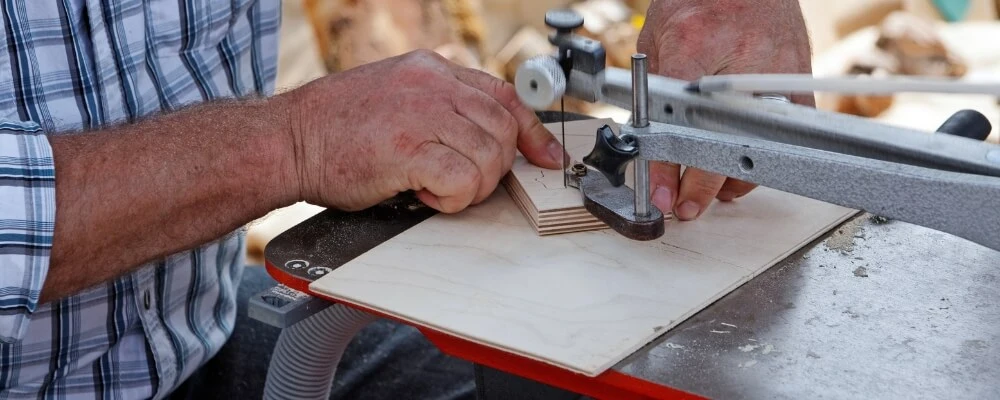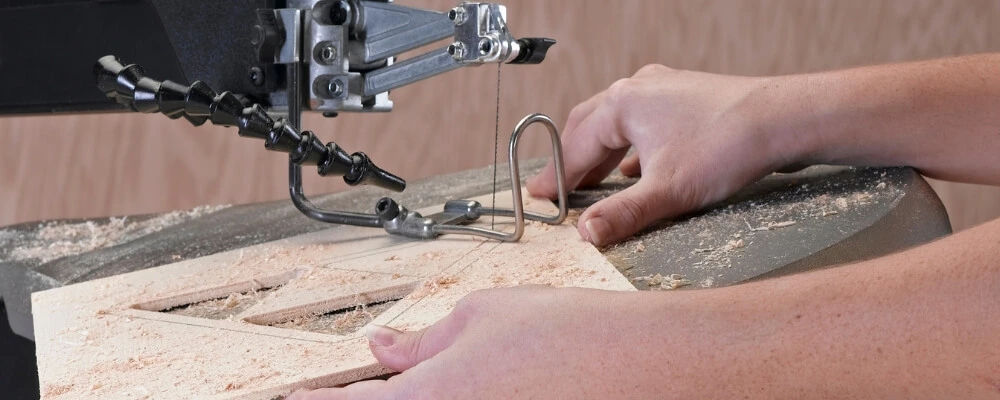The scroll saw an indispensable tool for many crafters and woodworkers, is renowned for its ability to create intricate designs and precise cuts with finesse. However, like all power tools, it demands respect and awareness of its potential dangers. Ensuring safety while operating such machinery is paramount, not just to protect the user but also to ensure the longevity of the tool and the quality of the work produced.
Whether you’re a seasoned scroll saw user or a beginner eager to dive into detailed woodworking, knowing safety protocols can make all the difference. This blog delve into 16 safety tips to keep you and your scroll saw in harmony, ensuring a safe and productive crafting experience. Join us as we navigate the path to safer scrolling.
Hazards Associated With Scroll Saw
Many potential hazards are associated with using a scroll saw, and it’s important to be aware of them. These include:
- Flying debris – Pieces of wood, sawdust, and other materials can fly off the saw during use and cause harm to you or those around you.
- Pinched fingers – If the blade slips, it can easily pinch your fingers between the blade and the wood.
- Electric shock – The electric current from the scroll saw can cause a shock if you are not using it correctly.
- Eye injury – Debris can fly into the operator’s eyes and cause injury.
- Noise – Scroll saws can be very loud and can cause damage to the ears if proper hearing protection is not worn.
- Burns – The saw blade can heat up continuously and cause burns if touched.
- Kickback – If the blade becomes stuck in the wood, the saw can kick back and cause injury.
- Fatigue – Operating a scroll saw for long periods of time can cause fatigue and make it difficult to concentrate.
- Unsecured material – It can move around while sawing, causing you to lose control of the blade and risk injury.
Scroll Saw Pre-Use Activities
- Thoroughly review and understand the information provided in the scroll saw operator’s manual, with particular attention given to descriptions of safety procedures.
- Before using, always inspect the scroll saw for damage or disrepair. In addition, ensure the blade teeth are pointing down and the saw blade is undamaged, sharp, and properly secured in a vertical position. Inspect the electrical cord and plug for defects.
- If the scroll saw fails your inspection, inform your group leader, parent, or guardian, and remove it from use until it can be repaired.

Safety Tips To Follow When Using A Scroll Saw
The scroll saw, a versatile tool favored by woodworkers and crafters alike, is well-known for creating intricate cuts and detailed work. However, as with all power tools, its efficiency comes with risks. Prioritizing safety ensures the integrity of your craftsmanship and your well-being. Here are 16 indispensable safety tips to consider while operating a scroll saw:
1. Wear Protective Gear
Despite being one of the less aggressive tools in a workshop, the scroll saw still poses potential threats. One of the common dangers is flying debris. Wood shavings, splinters, or even broken blade pieces can easily be projected into the air during operations. Safety glasses or a face shield serve as a first line of defense, ensuring that these do not become lodged in the eyes.
Moreover, cutting materials might produce dust or microscopic particles harmful when inhaled. A dust mask becomes crucial in such scenarios. Lastly, the persistent noise from the scroll saw, though often underestimated, can lead to long-term hearing problems. Ear protection helps to mitigate this risk, especially during prolonged use.
2. Avoid Loose Clothing and Accessories
The scroll saw’s blade operates at high speeds, and its motion is designed to grab and cut material efficiently. Anything that gets too close, like gloves, loose shirts, neckties, or jewelry, can easily be snagged.
Such occurrences pose a risk of damaging the tool or the project and, more critically, can pull the user’s hand or fingers into the blade, resulting in severe injuries.
3. Blade Guarding
The blade guard is a physical barrier between the user and the scroll saw blade. Before starting any cutting task, users should ensure that this guard is properly positioned and securely fixed.
It is pivotal in reducing the risk of direct contact with the blade, especially during inadvertent movements. Furthermore, a properly set blade guard can prevent larger debris from being thrown back towards the user.
4. Choose the Right Blade
The scroll saw is a versatile tool, and its efficacy is often tied to the blade type. Different blades are designed for various materials and types of cuts. For instance, a blade designed for softwood might burn or break when used on hardwood.
Using an inappropriate blade can damage the material or the saw and increase the risk of kickbacks or blade breaks. Therefore, understanding and selecting the correct blade requires craftsmanship and safety.
5. Ensure a Cutting Surface
The stability of the material being cut is paramount for safety. If a piece of wood or any other material does not sit flat on the saw’s table, it can rock, twist, or slip during the cut. Such unpredictable movements increase the chances of the blade binding or the material being ejected. Ensuring the material sits flat minimizes these risks, providing a safer and more controlled cutting experience.
6. Secure Your Workpiece
Even if a material lies flat on the table, it can still move during cutting. Any lateral or upward force can shift the piece, leading to inaccuracies or, worse, accidents. Using clamps or holding jigs provides additional security. It ensures that the workpiece remains stationary, allowing the user to focus on guiding the material rather than struggling to keep it in place.
7. Optimal Speed Selection
Scroll saws have variable speed settings for different materials and cut types. While it might be tempting to always operate at high speeds for faster results, matching the speed with the task at hand is essential.
For instance, intricate designs on delicate materials might require slower speeds for precision, while straight cuts on thicker materials can be done at higher speeds. The right speed reduces the risk of errors, kickbacks, or material burns.
8. Maintain a Safe Hand Position
One’s hand positioning while operating a scroll saw is vital for safety. Keeping fingers away from the direct path of the blade is a given. Still, it’s also crucial to ensure they remain at a safe distance, ideally at least two inches away.
This distance provides a safety buffer, reducing the chances of accidental slips that might result in injuries. Proper hand positioning also offers better control over the material, leading to more accurate cuts.

9. Use a V-Fixture for Round Stock
Cutting cylindrical materials with a scroll saw can be particularly challenging due to their rounded nature. The material can roll or shift, making precision cuts difficult and increasing the risk of accidents.
A V-fixture provides a solution to this problem. It cradles the cylindrical material, preventing it from rolling while offering a stable platform for cutting. Using such fixtures ensures a more precise cut and substantially enhances safety during the operation.
10. Power Off During Adjustments
A common cause of accidents in workshops is unintentional machine engagements. Always ensure the scroll saw is powered off before making any blade changes, adjustments, or simple measurements. This preventive measure ensures that the machine doesn’t accidentally turn on, which can cause serious injuries, especially when one’s fingers or hands are close to the blade.
11. Clear Debris Safely
Wood scraps, sawdust, and other debris can accumulate in the sawing area as you work. While it might be tempting to swipe these away with a hand swiftly, it’s a risky practice. Instead, use a stick, brush, or another tool to clear the debris. Doing so ensures that your hands remain safe from the blade, minimizing potential harm.
12. Stay Alert for Blade Issues
The blade is integral to the scroll saw, and any issues can escalate quickly. If you notice signs of the blade breaking, bending, or becoming loose, it’s crucial to act promptly. Step away from the machine and power it off immediately.
Only after you’re certain the machine is off should you approach and address the blade issue. This reactive approach ensures you remain safe even if unexpected blade issues arise.
13. Good Lighting is Essential
Visibility is key when working with tools that demand precision like the scroll saw. A well-lit workspace helps you see your markings, the blade’s path, and any potential issues with the material.
Adequate lighting reduces strain on the eyes, helps achieve accurate cuts, and reduces the risk of mistakes that might lead to accidents.
14. Always Unplug When Idle
Even if you’ve powered off the scroll saw, there remains a potential risk if it’s still plugged in. Unplugging the machine when not in use is a safety measure that eliminates the chances of unintended startups.
Whether due to a faulty switch, an electrical surge, or even accidental bumping, unplugging ensures the machine remains off until you’re ready to use it again.
15. Treat Injuries Promptly
No matter how many safety measures one takes, accidents can still occur. If you find yourself injured, treating the injury immediately is crucial. Even minor cuts or bruises can lead to complications if neglected.
Depending on the severity, seeking medical attention might be necessary. Remember, it’s always better to be safe than sorry.
16. The Right Tool for the Right Job
Scroll saws, like all tools, have been designed for specific tasks. While they excel at intricate cuts and delicate designs, they aren’t suitable for all jobs. Using the scroll saw for tasks outside its primary function might be tempting, but doing so can be both ineffective and dangerous.
Always ensure you’re using the right tool for the job at hand, ensuring both the quality of your work and your safety.
Conclusion
Mastering the scroll saw is as much about skill as safety. While offering endless possibilities for creativity, this intricate tool also has hazards. However, adhering to the 16 safety tips outlined in this blog ensures that your woodworking journey is productive and safe.
Remember, the best craftsmanship comes from a foundation of respect for the tools we use. By taking the necessary precautions, not only do you protect yourself, but you also enhance the quality and precision of your work. As you continue exploring the world of scroll sawing, let safety be your steadfast companion, ensuring every cut is artful and secure.





